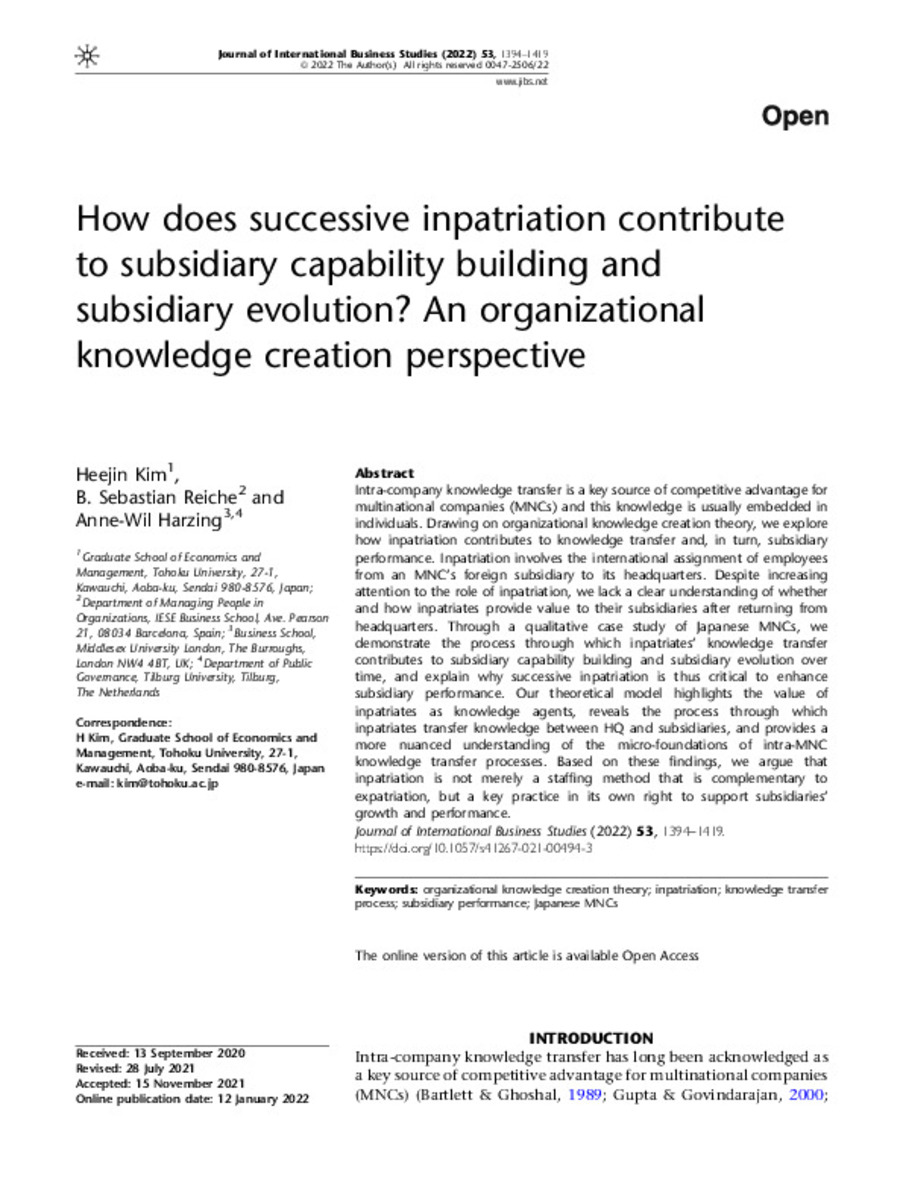Full metadata record
| DC Field | Value | Language |
|---|---|---|
| dc.creator | Kim, H. (Heejin) | - |
| dc.creator | Reiche, B.S. (B. Sebastian) | - |
| dc.creator | Harzing, A.W. (Anne-Wil) | - |
| dc.date.accessioned | 2022-10-04T07:42:37Z | - |
| dc.date.available | 2022-10-04T07:42:37Z | - |
| dc.date.issued | 2022-01-12 | - |
| dc.identifier.citation | Kim, H., Reiche, B.S. & Harzing, AW. How does successive inpatriation contribute to subsidiary capability building and subsidiary evolution? An organizational knowledge creation perspective. Journal of International Business Studies 53, 1394–1419 (2022). https://doi.org/10.1057/s41267-021-00494-3 | es_ES |
| dc.identifier.issn | 1478-6990 | - |
| dc.identifier.uri | https://hdl.handle.net/10171/64366 | - |
| dc.description.abstract | Intra-company knowledge transfer is a key source of competitive advantage for multinational companies (MNCs) and this knowledge is usually embedded in individuals. Drawing on organizational knowledge creation theory, we explore how inpatriation contributes to knowledge transfer and, in turn, subsidiary performance. Inpatriation involves the international assignment of employees from an MNC’s foreign subsidiary to its headquarters. Despite increasing attention to the role of inpatriation, we lack a clear understanding of whether and how inpatriates provide value to their subsidiaries after returning from headquarters. Through a qualitative case study of Japanese MNCs, we demonstrate the process through which inpatriates’ knowledge transfer contributes to subsidiary capability building and subsidiary evolution over time, and explain why successive inpatriation is thus critical to enhance subsidiary performance. Our theoretical model highlights the value of inpatriates as knowledge agents, reveals the process through which inpatriates transfer knowledge between HQ and subsidiaries, and provides a more nuanced understanding of the micro-foundations of intra-MNC knowledge transfer processes. Based on these findings, we argue that inpatriation is not merely a staffing method that is complementary to expatriation, but a key practice in its own right to support subsidiaries’ growth and performance. | es_ES |
| dc.description.sponsorship | This work was supported by JSPS KAKENHI Grant Numbers JP12926992, JP12808804, JP14445974, and JP20243632. | es_ES |
| dc.language.iso | eng | es_ES |
| dc.publisher | Springer | es_ES |
| dc.rights | info:eu-repo/semantics/openAccess | es_ES |
| dc.subject | Organizational knowledge creation theory | es_ES |
| dc.subject | Inpatriation | es_ES |
| dc.subject | Knowledge transfer process | es_ES |
| dc.subject | Subsidiary performance | es_ES |
| dc.subject | Japanese MNCs | es_ES |
| dc.title | How does successive inpatriation contribute to subsidiary capability building and subsidiary evolution? An organizational knowledge creation perspective | es_ES |
| dc.type | info:eu-repo/semantics/article | es_ES |
| dc.description.note | This article is licensed under a Creative Commons Attribution 4.0 International License | es_ES |
| dc.editorial.note | Springer | es_ES |
| dc.identifier.doi | 10.1057/s41267-021-00494-3 | - |
| dadun.citation.endingPage | 1419 | es_ES |
| dadun.citation.publicationName | Journal of International Business Studies | es_ES |
| dadun.citation.startingPage | 1394 | es_ES |
| dadun.citation.volume | 53 | es_ES |
Files in This Item:
Statistics and impact
Items in Dadun are protected by copyright, with all rights reserved, unless otherwise indicated.






